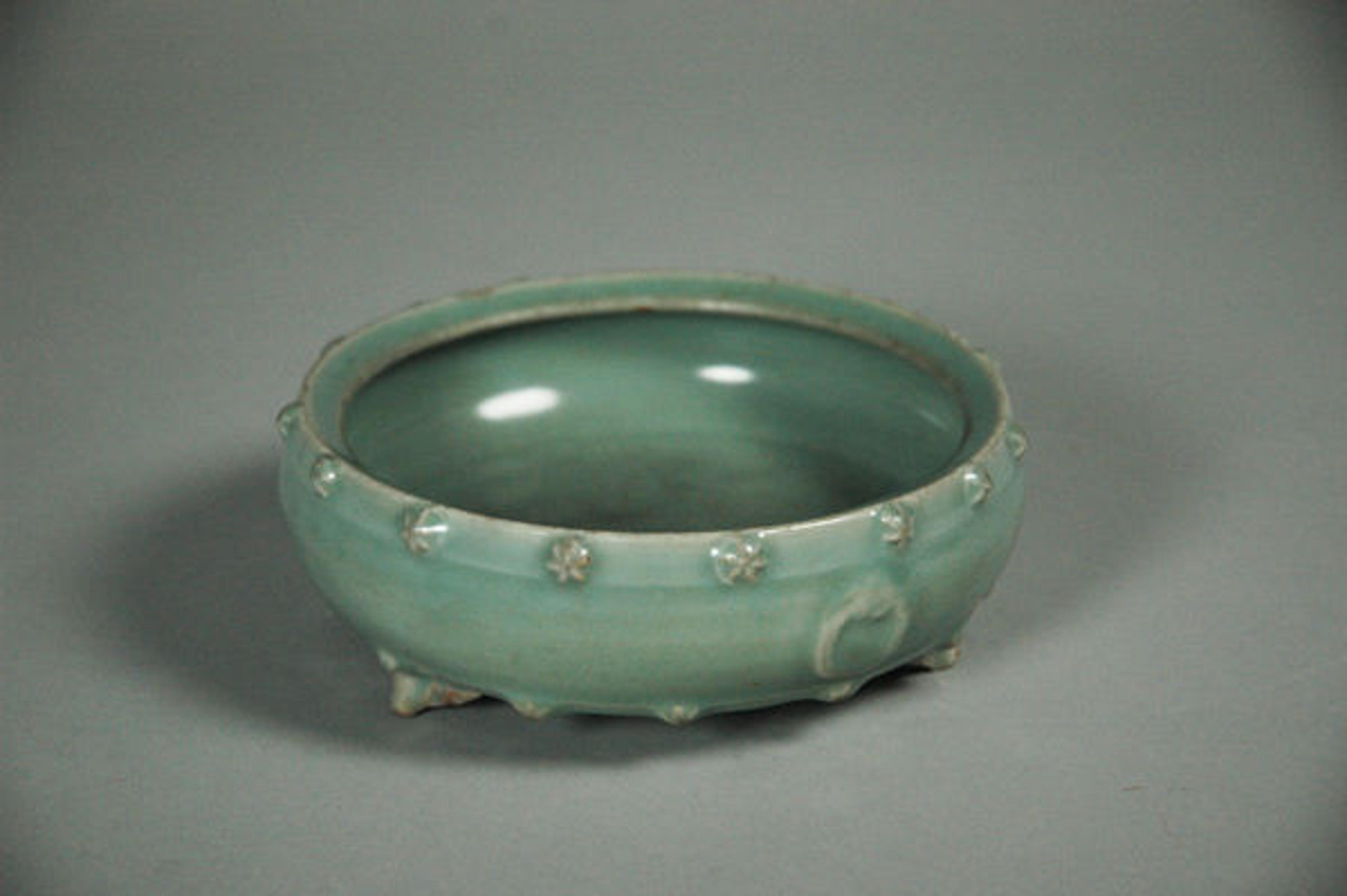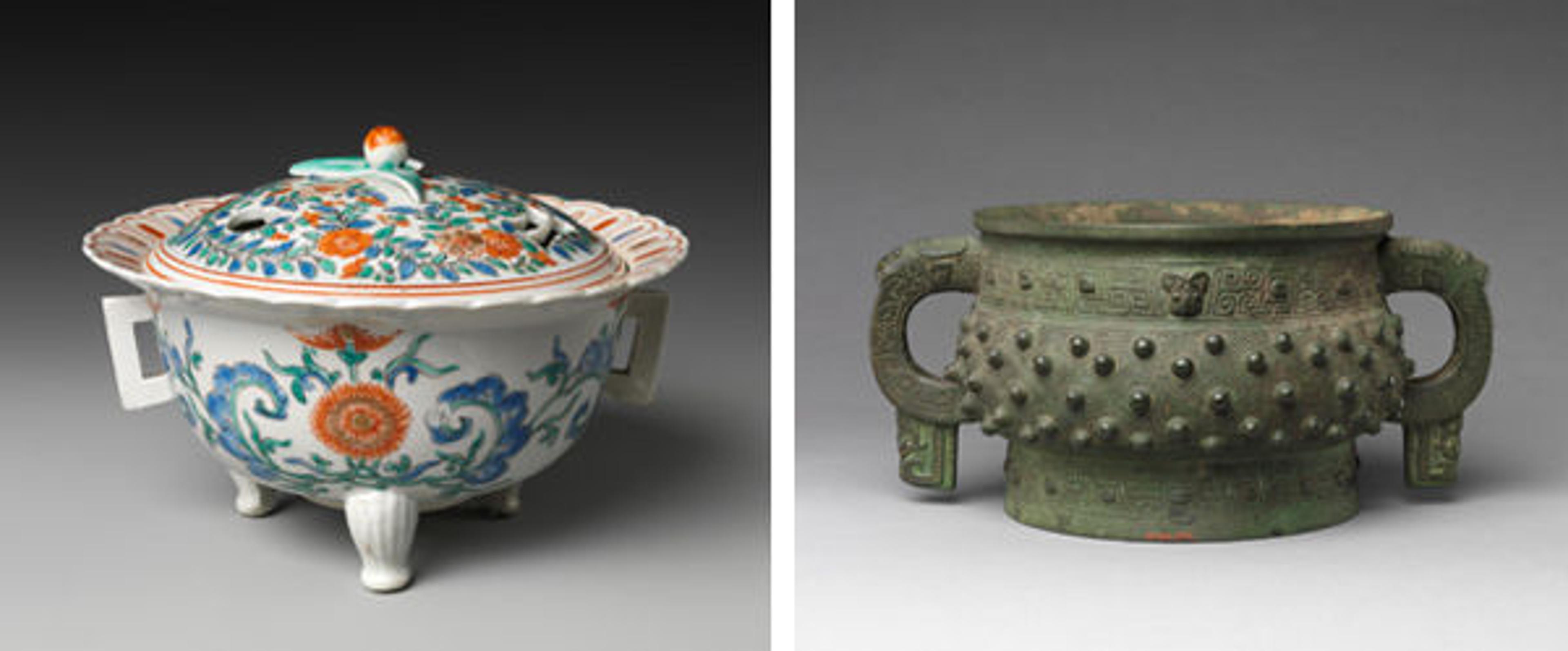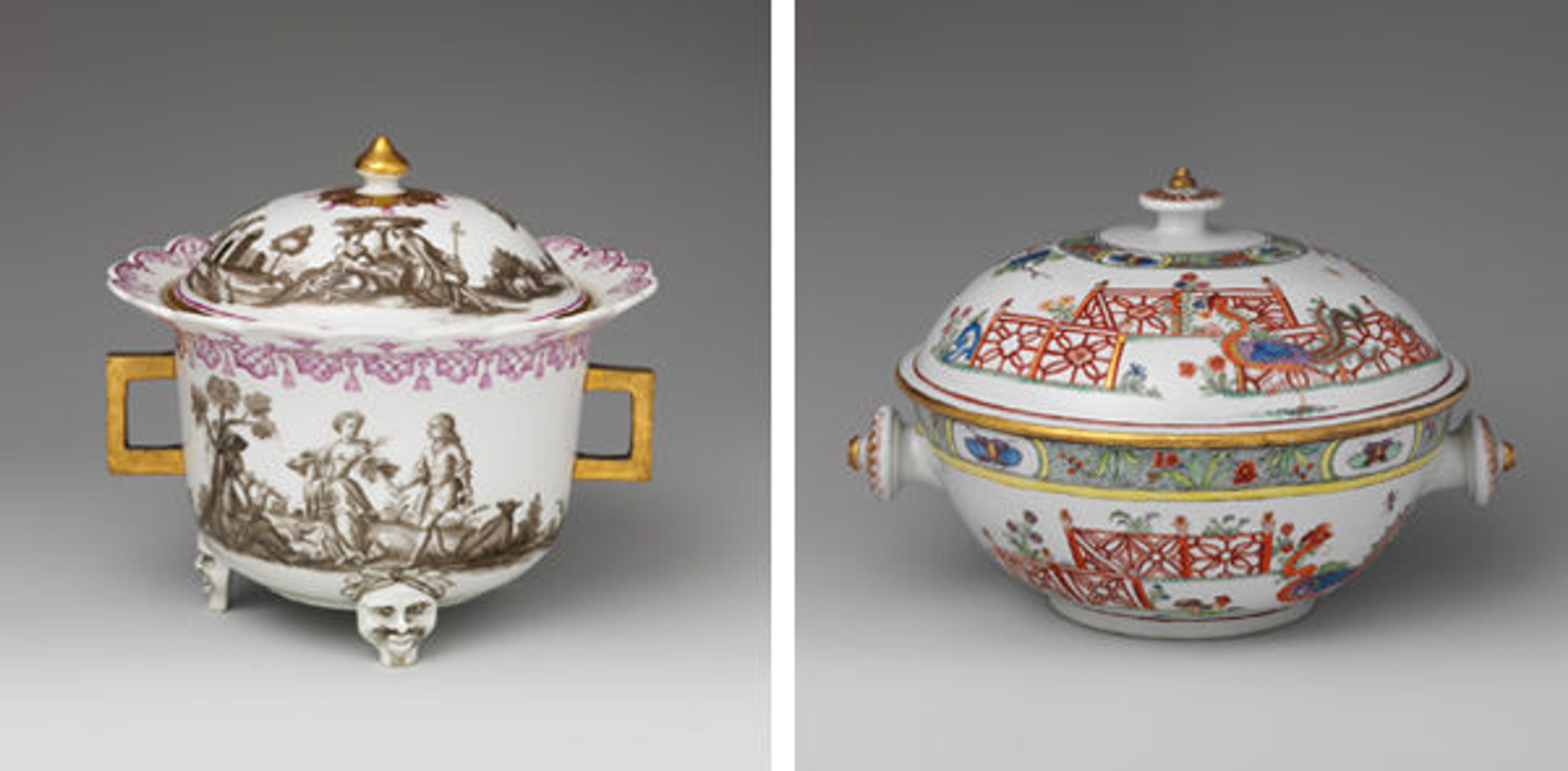
Fig. 1 (left). Ritual tripod cauldron (ding), 11th century B.C. China. Shang dynasty (ca. 1600–1046 B.C). Bronze inlaid with black pigment; H. 6 in. (15.2 cm). The Metropolitan Museum of Art, New York, Purchase, Arthur M. Sackler Gift, 1974 (1974.268.20). Fig. 2 (right). Ritual tripod cauldron (ding), inscription dated to 994–989 B.C. China. Western Zhou dynasty (ca. 1046–771 B.C.). Bronze; H. 4 1/4 in. (10.8 cm). The Metropolitan Museum of Art, New York, Gift of Paul E. Manheim, 1969 (69.251)
«This spring, the subject of cultural exchange between China and the West has been a hot topic thanks to the exhibition China: Through the Looking Glass, a collaboration between The Costume Institute and the Department of Asian Art. Yet fashion is by no means the only arena in which Western artists have been inspired by Chinese objects. For instance, bronze ritual vessels known as ding (figs. 1 and 2), which emerged during China's Bronze Age (ca. 1600–221 B.C.), have long inspired objects ranging from Korean chaekgori screens to Viennese bowls.»
Based on an earlier ceramic shape, ding vessels—characterized by rounded bodies, three legs, and facing handles—were used for cooking and serving food, usually offerings to ancestors or the gods. By the twelfth century B.C., the use of ding and the rights to perform such rituals had become the prerogative of privilege, and a famous but now lost group of nine such vessels was understood to symbolize the rightful rule of the king. By that time, the number of ding and other ritual vessels permitted to nobles varied according to their rank.

Fig. 3. Container for bulbs, 13th–early 14th century. China. Southern Song dynasty (1127–1279). Stoneware with applied decoration under celadon ware (Longquan ware); H. 2 1/4 in. (5.7 cm); Diam. 6 1/2 in. (16.5 cm). The Metropolitan Museum of Art, New York, Gift of Mrs. Samuel T. Peters, 1926 (26.292.79)
The shape of ding tripods was rediscovered as part of the engagement with earlier traditions that characterized the Song dynasty (960–1279) (fig. 3). Thereafter, it became a standard in Chinese ceramics (fig. 4) and metalwork (fig. 5), often, but not always, serving as an incense burner.

Fig. 4 (left). Incense burner with lotuses, early 16th century. China. Ming dynasty (1368–1644), Zhengde mark and period (1506–1521). Porcelain painted with cobalt blue under transparent glaze (Jingdezhen ware); H. 4 1/2 in. (11.5 cm). The Metropolitan Museum of Art, New York, Gift of Stanley Herzman, in memory of Gladys Herzman, 1997 (1997.1.12). Fig. 5 (right). Censer, ca. 18th century. China. Qing dynasty (1644–1911). Bronze with treated surface; Diam. 5 in. (13 cm). The Metropolitan Museum of Art, New York, Robert Lehman Collection, 1975 (1975.1.1427)
In addition, representations of ding are included in a Chinese visual theme known as the "Hundred Antiquities" (fig. 6), as well as in Korean chaekgori screens, where they are incorporated into intriguing groupings of books, rarities, and scholarly accoutrements understood to represent knowledge and authority (fig. 7).

Fig. 6 (left). Table valance with theme of the "Hundred Antiquities" (detail), 18th century. China. Qing dynasty (1644–1911). Embroidery on silk gauze; 32 x 98 in. (81.3 x 248.9 cm). The Metropolitan Museum of Art, New York, Bequest of William Christian Paul, 1929 (30.75.15). Fig. 7 (right). Books and Scholar's Possessions (detail), early 20th century. Korea. Ten-panel folding screen; ink and color on silk; Each image: 40 1/2 x 12 1/2 in. (102.9 x 31.8 cm). The Metropolitan Museum of Art, New York, Purchase, Shelby White Gift, 2005 (2005.385)
The ding also reached Japan, where it continued to serve as an incense burner. The two square handles on this seventeenth-century Japanese example (fig. 8), however, come from another ritual vessel known as a gui, which also has a rounded body but stands on a solid foot (fig. 9). Like the ding, the gui were used for offering food, primarily grains, to the ancestors.

Fig. 8 (left). Incense burner (koro), late 17th century. Japan. Edo period (1615–1912). Hard-paste porcelain painted with cobalt blue under and colored enamels over transparent glaze (Hizen ware; Kakiemon type); H. 4 1/2 in. (10.5 cm). The Metropolitan Museum of Art, New York, The Hans Syz Collection, Gift of Stephan B. Syz and John D. Syz, 1995 (1995.268.114 a, b). Fig. 9 (right). Ritual grain vessel (Gui), 12th–11th century B.C. China. Shang dynasty (ca. 1600–1046 B.C.). Bronze; H. 6 in. (15. 2 cm). The Metropolitan Museum of Art, New York, John Stewart Kennedy Fund, 1913 (13.100.155)
Parallels between the shape of this Japanese incense burner and that of a small covered bowl made in Austria around 1725 (fig. 10), can be traced to the development of global trade, particularly in porcelain, that began in the late sixteenth century and flourished from the seventeenth to the nineteenth. Like the Japanese incense burner, the Viennese bowl stands on small legs (here embellished with fanciful Baroque faces) and has a rounded body—elements derived from the ding. It also features square handles derived from the gui. The use of both small and large footed bowls can be traced to the late seventeenth century, when changes in European dining altered the communal bowl into the tureen, a richly decorated piece (fig. 11) that served as the centerpiece of a formal table.

Fig. 10 (left). Covered bowl with figures in landscape, ca. 1725. Austria, Vienna. Du Paquier period (1718–1744). Hard-paste porcelain painted with colored enamels over transparent glaze; H. 6 in (15.2 cm). The Metropolitan Museum of Art, New York, The Hans Syz Collection, Gift of Stephan B. Syz and John D. Syz, 1995 (1995.268.303a, b). Fig. 11 (right). Tureen with phoenixes in landscape, 1725–30. Austria, Vienna. Du Paquier period (1718–1744). Hard-paste porcelain porcelain painted with colored enamels over transparent glaze; H. 8 1/4 in. (21 cm). The Metropolitan Museum of Art, New York, The Hans Syz Collection, Gift of Stephan B. Syz and John D. Syz, 1995 (1995.268.281a, b)
It is fascinating to note that by eliminating the holes piercing the cover and slightly changing the proportions of its Japanese prototype, the Viennese bowl became, once again, a food container, reverting to the earliest and original function of the long-lived and endlessly useful three-footed ding.